Pumpkins are extremely popular and tasty, and we use them in many different versatile ways. As we know, one of the signature things that represent Halloween is pumpkins. It is a fruit from a botanist’s perspective, but people use it more like a vegetable because of its taste. Now let’s talk about guinea pigs and whether they can enjoy this delicious and nutritious fruit.
Can guinea pigs eat pumpkin? Yes, but only in moderation. Pumpkin contains vital nutrients such as vitamins C and A, but due to sugar, it needs to be regulated. Guinea pigs really love the taste of pumpkin flesh, and the only real danger is the seeds that can present a choking hazard.
In the following sections, we will also discuss all facts, information, nutrients, risks, benefits, and everything you need to know about pumpkin as food for your lovely guinea pig. In addition, we will also provide you with information on how to feed a guinea pig pumpkin. Let’s start!
Table of Content
Is Pumpkin Good for Guinea Pigs? | Health Benefits

Healthy Weight
The pumpkin is relatively low in calories, so the guinea pigs will not be at risk of obesity or major weight changes at all. This amount of calories will maintain a healthy weight for them. Pumpkin may be sweet in taste, but it is low in fat, as well.
So, we can say that pumpkin is not a fattening type of food. Also, there are not a lot of carbs and protein. That’s also good for a healthy weight and just enough to provide quick and slow-release energy for the daily needs of your guinea pigs.
Antioxidants
Vitamin A is a strong antioxidant that fights inflammation, prevents diseases caused by free radical damage, keeps the kidneys, skin, heart, eyes, and lungs healthy. This vitamin will be keeping the overall health and immunity of the guinea pigs in great shape. Also, there is vitamin E which keeps the skin healthy and potentially prevents cancer and inflammation.
Scurvy Prevention
Pumpkin has vitamin C. Sadly, the guinea pigs don’t produce this vitamin naturally. They get this vitamin through supplements or foods. This way, they are safe from getting scurvy. This disease damages their fur, reduces their appetite, causes loose stool, and internal bleeding. Unfortunately, the amounts of vitamin C in pumpkins are average at best and not like in some other fruits and vegetables.
Healthy Blood and Cardiovascular System
The guinea pig will be safe from anemia and other blood-related problems, such as clogged blood vessels. Thiamin, also named vitamin B1, keeps nerves healthy and promotes a good flow of electrolytes in cells and muscles. Riboflavin, known as the B2 vitamin, breaks down all foods into energy and transports oxygen throughout the organism. Potassium also regulates blood pressure, and its deficiency causes fatigue and constipation.
Good for Eyesight
Pumpkin is an important source of carotenoids such as beta-carotene, alfa-carotene, lutein, and zeaxanthin. Beta-carotene is the most important carotenoid in pumpkins because it’s useful for preventing vitamin A deficiency. All these carotenoids have antioxidant activity and, together with vitamin A and vitamin E, are good for guinea pigs’ eyesight.
Nutrition Facts of Pumpkin for Guinea Pigs
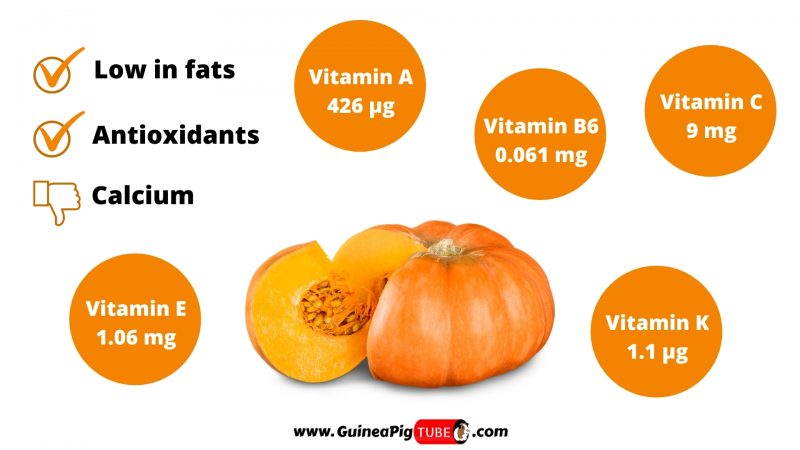
These are the nutrition facts for 100g of pumpkin:
- Energy – 26 kcal
- Protein – 1 g
- Total lipid (fat) – 0.1 g
- Carbs – 6.5 g
- Dietary Fiber – 0.5 g
- Sugars – 2.76 g
- Calcium – 21 mg
- Iron – 0.8 mg
- Magnesium – 12 mg
- Phosphorus – 44 mg
- Potassium – 340 mg
- Sodium – 1 mg
- Zinc – 0.32 mg
- Copper – 0.127 mg
- Manganese – 0.125 mg
- Selenium – 0.3 µg
- Vitamin C – 9 mg
- Vitamin B-6 – 0.061 mg
- Vitamin E – 1.06 mg
- Vitamin K – 1.1 µg
- Vitamin A – 426 µg
- Thiamin – 0.05 mg
- Riboflavin – 0.11 mg
- Folates – 16 µg
- Carotene, beta – 3100 µg
- Carotene, alpha – 4016 µg
- Lutein + zeaxanthin – 1500 µg
Risks to Consider When Feeding Pumpkin to Guinea Pigs

Urinary Problems
Sadly, the amount of calcium in pumpkin is too high for the guinea pigs because, in large amounts, it causes them urinary problems. Calcium is good only when they are young as it helps them form strong bones during development and growth. But, fully grown guinea pigs are at risk of urinary stones, pain during urination or blood in urine, and infections in the urinary tract if they have too much calcium in their food.
Digestion Pains and Diarrhea
Pumpkin is sweet, which means it contains some sugar. The sugar in the pumpkin is not the best nutrient for the guinea pigs because it will cause them painful digestion, especially if it’s served in large amounts.
Sugar is not well digested by guinea pigs. Their stomachs are fragile, and with excess sugar that comes with large serving sizes, they will have stomach pains and diarrhea.
Serving Size and Frequency of Pumpkin for Guinea Pigs
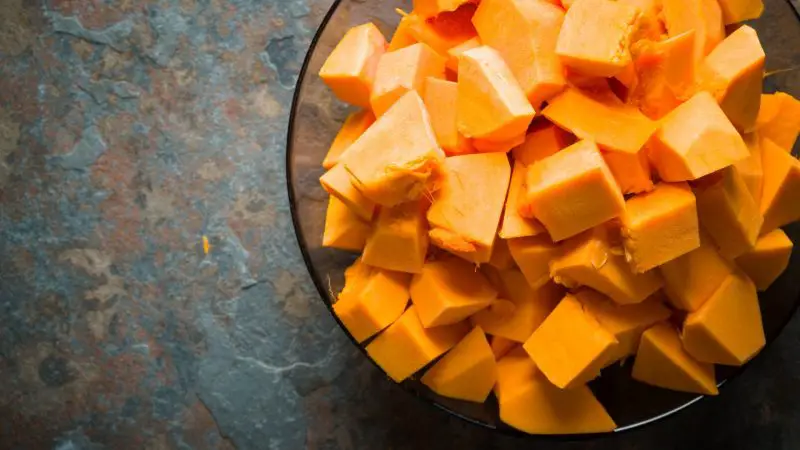
Can Guinea Pigs Have Pumpkin Every Day?
Guinea pigs shouldn’t eat pumpkins every day. They need only hay and water every day, so you need to regulate the frequency of other fruits and vegetables. Guinea pigs’ daily diet shouldn’t be based only on pumpkins because pumpkins aren’t so rich in vitamin C.
On average, they need 10 to 30 mg of vitamin C daily. So besides pumpkins, you should provide them some food that has more vitamin C. Pumpkins should be given not more than 2 times per week to your guinea pigs. This way, they will have a balanced diet with enough beneficial vitamins and minerals.
How Much Pumpkin Can Guinea Pigs Eat?
You can give one guinea pig a small handful amount of pumpkin, or a few chunks/pieces. That’s enough pumpkin for one serving size and for providing it with enough amount of vitamins and minerals.
Guinea pigs shouldn’t eat a lot of pumpkins because that can lead to serious digestive problems such as diarrhea, vomiting, or gases. If we are talking about a longer period of time, too many pumpkins can cause bladder or kidney stones due to calcium.
What Part of a Pumpkin Can Guinea Pigs Eat?
In the following sections, find out can guinea pigs eat the inside of a pumpkin and are pumpkin seeds safe for a guinea pig to eat. Also, read more about pumpkin leaves, flowers, and is pumpkin skin good for guinea pigs. Let’s see!
Can Guinea Pigs Eat Pumpkin Seeds?
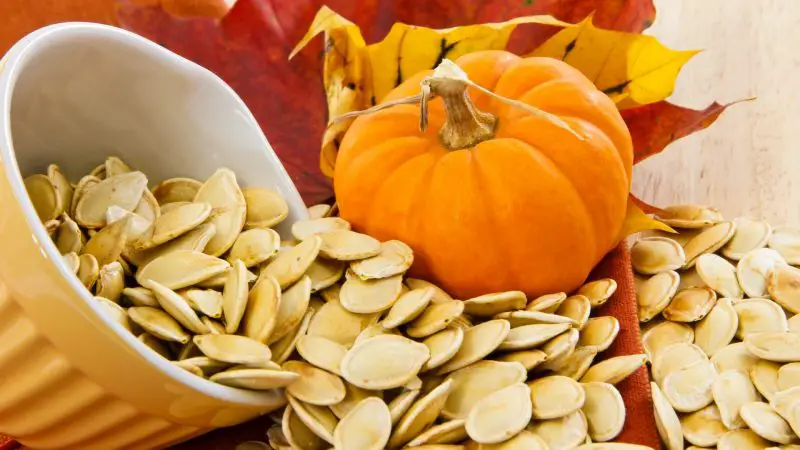
Guinea pigs can’t eat pumpkin seeds. As most other types of seeds, they are not good at all for the guinea pigs. Pumpkin seeds aren’t poisonous to guinea pigs. They can’t eat these seeds partially because they are fattening, but the greatest risk is that they can be a choking hazard for them. The guinea pigs won’t be able to chew them properly, and they can get stuck in their mouth and throat.
Guinea pigs can’t eat baked pumpkin seeds or dried pumpkin seeds. That’s an even worse option for them. Guinea pigs can’t eat any cooked or processed food because their digestive system isn’t made to process cooked food. So, avoid any kind of pumpkin seeds in the guinea pig’s diet.
Can Guinea Pigs Eat Pumpkin Skin/Pumpkin Peel?
Guinea pigs can eat pumpkin skin or pumpkin peel, but only in moderation. Some studies have reported that pumpkin skin has more nutrients than pumpkin flesh. This skin is high in antioxidants, vitamins, and minerals. It’s completely safe to feed guinea pigs with pumpkin skin if it has been cleaned properly. Guinea pigs will enjoy chewing on the pumpkin skin, and it can also be beneficial to their teeth.
Can Guinea Pigs Eat Pumpkin Guts/Pumpkin Pulp?
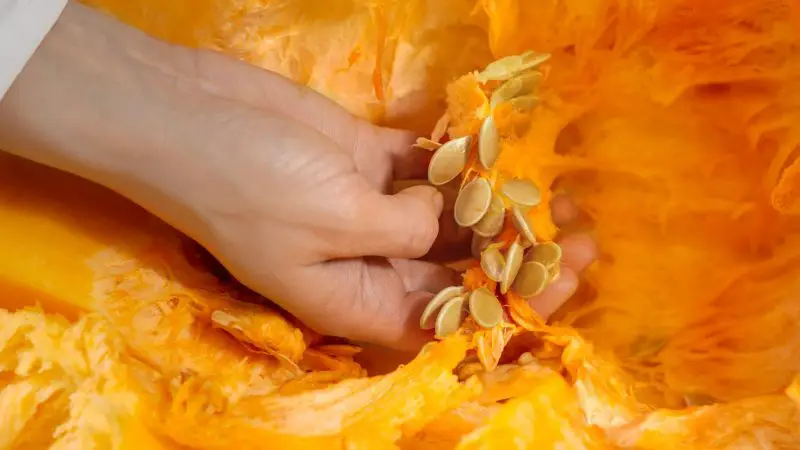
Guinea pigs can eat pumpkin guts or pumpkin pulp because it has many beneficial nutrients for them. Pumpkin pulps are rich in carotenoids, lutein, zeaxanthin, minerals, and vitamins. The most important vitamins are vitamin A, vitamin E, and vitamin C. Because of these carotenoids and vitamins, pumpkin pulps are such a nutritionally valuable part of the pumpkin. Just be sure to remove all the seeds before giving this part to guinea pigs.
Can Guinea Pigs Eat Pumpkin Flesh?
Guinea pigs can eat pumpkin flesh as well. That’s the part they will enjoy the most. You could cut the flesh into smaller pieces or give them a whole slice of pumpkin flesh to chew on. Just be careful with serving sizes and don’t give them too much at once. Pumpkin flesh is also rich in beneficial nutrients, and guinea pigs will love it.
Can Guinea Pigs Eat Pumpkin Flowers?
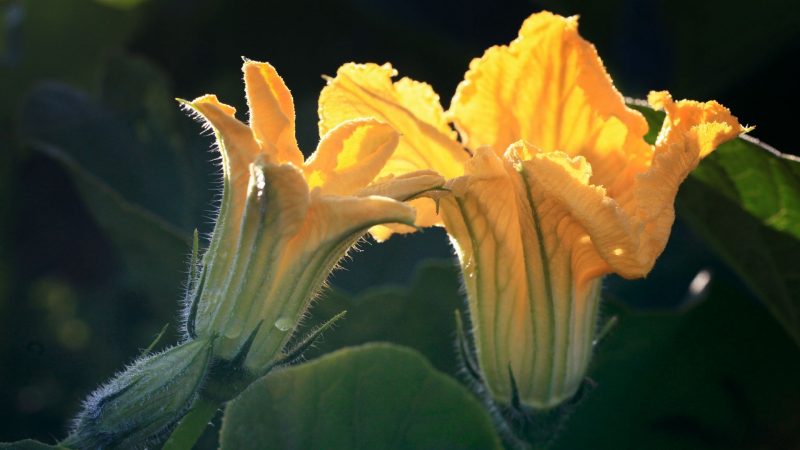
Guinea pigs can eat pumpkin flowers, and they are completely safe for them and even for humans. These yellow flowers have a slightly sweet taste with a pumpkin flavor. Interestingly, pumpkin flowers have more vitamin C than pumpkin fruit, and the flower is known to have many health benefits. Due to calcium content, it’s recommended to feed guinea pigs with pumpkin flowers only in moderation. Also, wash them carefully with water and give them only fresh pumpkin flowers.
Can Guinea Pigs Eat Pumpkin Leaves?
Guinea pigs can eat pumpkin leaves but only in minimal amounts and not too often. Pumpkins have huge green leaves with some tiny spines on them. Due to spines pumpkin leaves need to be prepared before giving them to guinea pigs. This means you need to peel them, i.e., remove prickly spines from the leaves.
Also, you need to wash pumpkin leaves thoroughly with water to remove any pesticides, insets, or dust. Give them only fresh and young pumpkin leaves. Leaves are very rich in vitamin A and other vitamins, antioxidants, and minerals. But, considering that pumpkin leaves contain a huge amount of calcium and don’t that they don’t have a lot of vitamin C, it’s recommended to feed them to guinea pigs only in moderation.
Can Guinea Pigs Eat Pumpkin Stem?
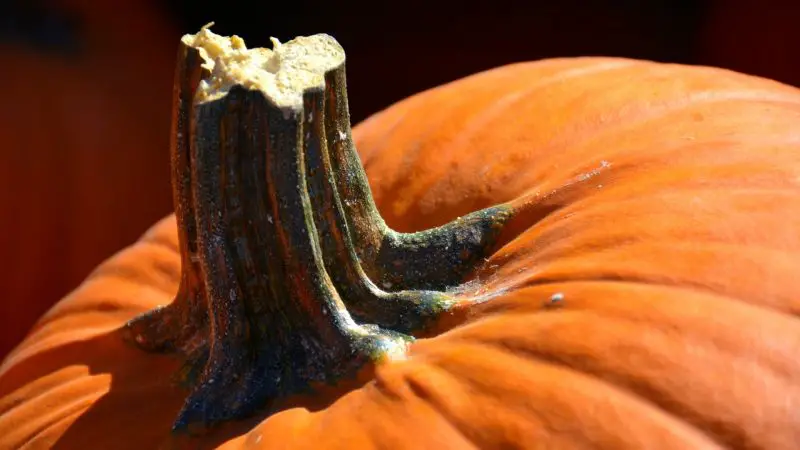
Guinea pigs can eat the pumpkin stem, but a better option would be pumpkin leaf stems. Pumpkin stem is too hard for guinea pigs, and they might have difficulties chewing them. Pumpkin stems from leaves are ideal for keeping their teeth healthy.
Like pumpkin leaves, you need to remove little spikes from the stem because they can be painful and itchy to guinea pigs. Also, give them pumpkin stems only in small serving sizes.
More Information About Guinea Pigs and Pumpkin
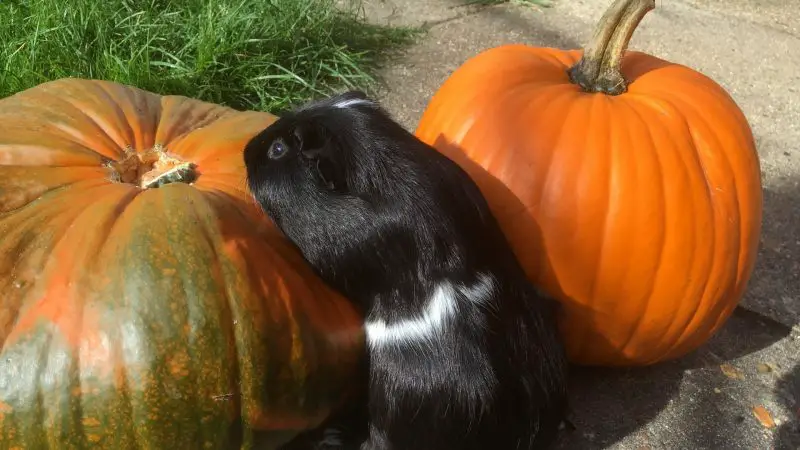
Can Guinea Pigs Eat Raw Pumpkin?
Guinea pigs can eat raw pumpkin. They are herbivores and can eat only raw and fresh pumpkins and other fresh fruits and vegetables. Never give to guinea pigs cooked or processed pumpkin because their digestive system isn’t made to digest that type of food.
Be sure to feed them only raw and fresh pumpkin flesh, leaves, flowers, and peels. If the pumpkin has stayed too long or has some color changes, it could potentially upset the guinea pig’s stomach.
Can Guinea Pigs Eat Canned Pumpkin or Pumpkin Puree?
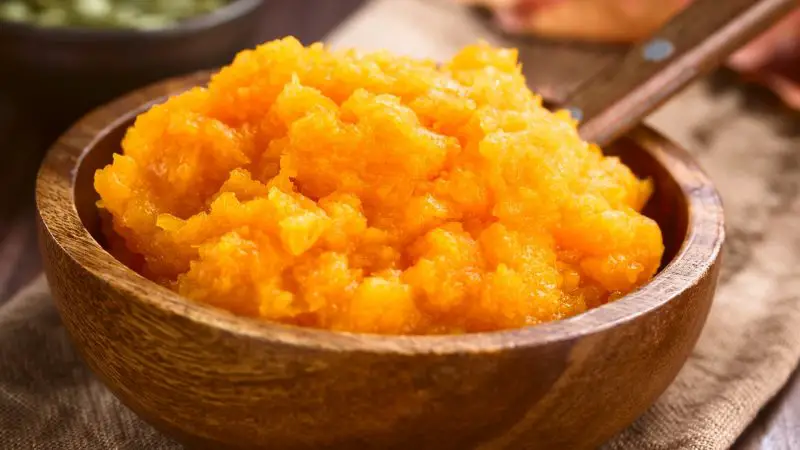
Guinea pigs shouldn’t eat canned pumpkin or pumpkin puree. This way, pumpkin is processed, and as we have said, guinea pigs can’t eat processed or cooked food. They have a very sensitive digestive system, and processed food can cause pain to their stomach. Also, canned pumpkin or pumpkin puree may have added sugar, salt, or other additives that may irritate the guinea pig’s stomach and cause health problems.
Can Guinea Pigs Eat Butternut Pumpkin?
Guinea pigs can eat butternut pumpkin, also known as butternut squash. This pumpkin has a good amount of essential nutrients that guinea pigs need for good health. Those nutrients are vitamin C, vitamin A, vitamin E, and many other vitamins and minerals.
It would be best if you fed butternut pumpkin to guinea pigs only in moderation because of the high amount of calcium. Just be sure to wash the skin thoroughly with water and give them only a small amount of skin to chew on it.
Can Guinea Pigs Eat Kent Pumpkin?
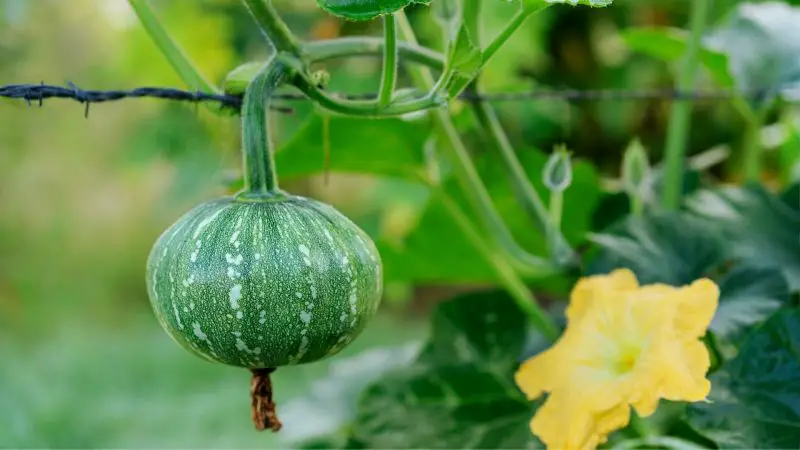
Kent pumpkin is a variety of Jap pumpkin with green and grey mottled skin and very soft and flavored yellow to orange flesh. Guinea pigs can eat Kent pumpkin because it is an excellent source of beneficial nutrients, such as antioxidants, vitamins, and minerals.
One of its essential nutrients is beta carotene, but also vitamin C and vitamin E. If consumed in excess, Kent pumpkin can upset the guinea pig’s stomach, so be careful with serving sizes and frequency.
Can Guinea Pigs Eat Mini Pumpkins?
Guinea pigs can eat mini pumpkins. These pumpkins are mini versions of large pumpkins, with deeply ribbed and hard orange skin. Mini pumpkins have yellow to orange flesh and are mildly sweet in taste. They are also nutritious for guinea pigs, due to beta carotene, vitamin C, vitamin A, and other vitamins and minerals.
Can Guinea Pigs Eat Pumpkin Pie?
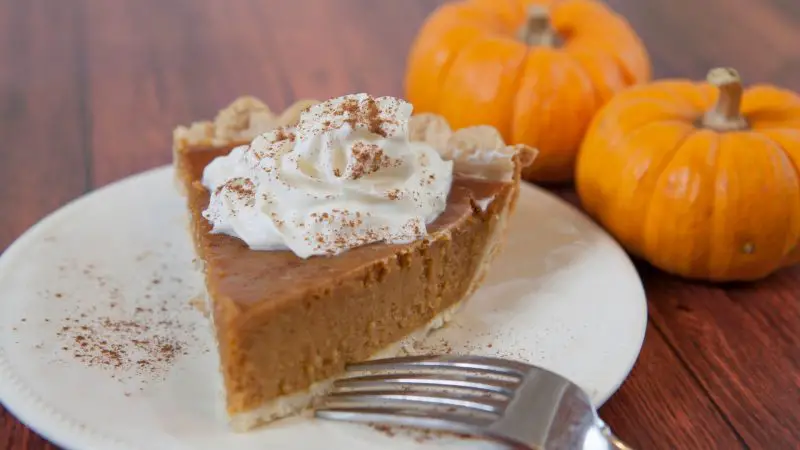
Guinea pigs can’t eat pumpkin pie because that can really upset their digestive system. Pumpkin pie is very unhealthy for them due to some of the ingredients and because of the fact that it is a type of cooked food. This pie is full of carbs, calories, fat, and sugar.
There is a huge amount of calcium and a lack of vitamin C, as well. Pumpkin pie has nothing beneficial to guinea pigs. Also, it contains flour, milk, eggs, added sugars and salt, butter, and other nutrients that are completely forbidden to guinea pigs.
Can Guinea Pigs Have Pumpkin Spice Latte?
Guinea pigs can’t have pumpkin spice latte, as this drink is also very unhealthy for them. Pumpkin spice latte is rich in calories, fat, carbs, sugars, and calcium while lacking vitamin C and other beneficial vitamins and minerals. The only fluid that guinea pigs can drink is water. They need a daily supply of clean and fresh water, so be sure to have enough water bottles or water bowls in their cage all the time.
Quick Facts on Pumpkin
- The pumpkins belong in the family of honeydew melons, cucumbers, zucchini, cantaloupe, and watermelons.
- Pumpkins originated from Mexico and Central America.
- The word pumpkin first originated from the Greek word “Pepon” (large melon). After this, the word went through many adaptations by the French and English translations.
- In 1584, Jacques Cartier, a French explorer of North America, called this fruit “a gross melon.” Later, this term in English was translated as “pompions,” which is now known as “pumpkin.”
- The heaviest pumpkin in the world weighed 820 kg and was found in Minnesota.
- Pumpkins are planted during May and June, and they are picked in October when they reach their vibrant orange color.
- Pumpkins are technically a fruit, but in culinary terms, we consider them to be vegetables.
- There is archeological evidence for the first domesticated pumpkins, dating back to 7000 years ago in Mexico.
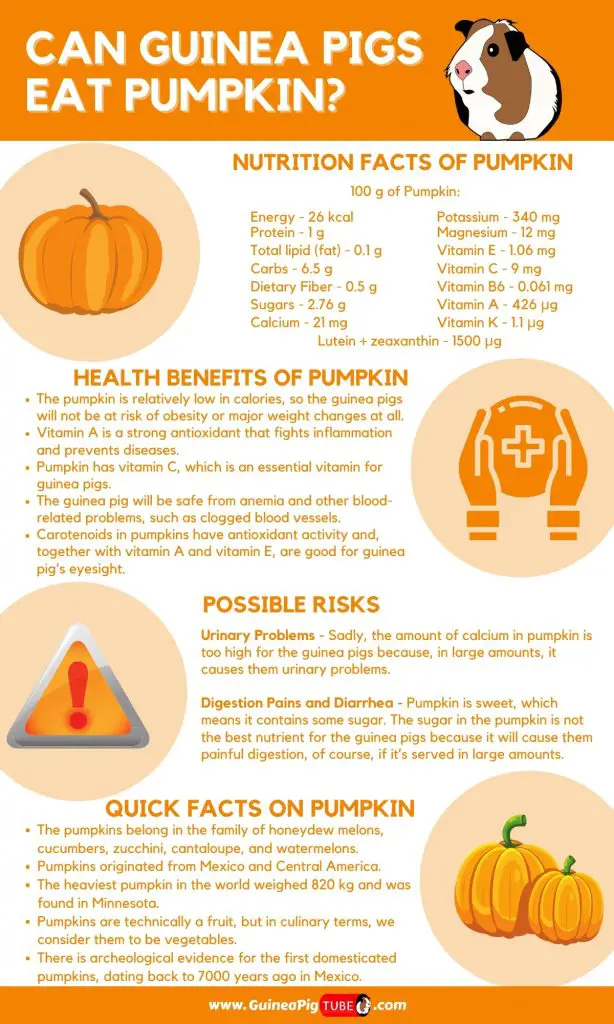
With food, you should be careful what to choose. If you are not sure what to feed them but believe your little piggies deserve some great treats, check our Helpful Guide to the Best Guinea Pig Treats to get some ideas.
We have also made a full list of foods that guinea pigs can and can’t eat (150+ Types of Foods). Be sure to also check our recommended products page for everything you will ever need to assure a happy life for your Guinea Pigs. Hope this information was helpful and you have found the answer you were looking for.
List of Sources
Nutrient Requirements of Laboratory Animals: Fourth Revised Edition
The Effects of Diet on Anatomy, Physiology and Health in the Guinea Pig
Medicinal and Biological Potential of Pumpkin: An Updated Review
